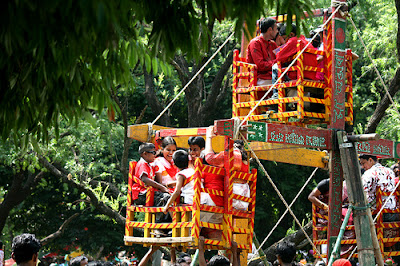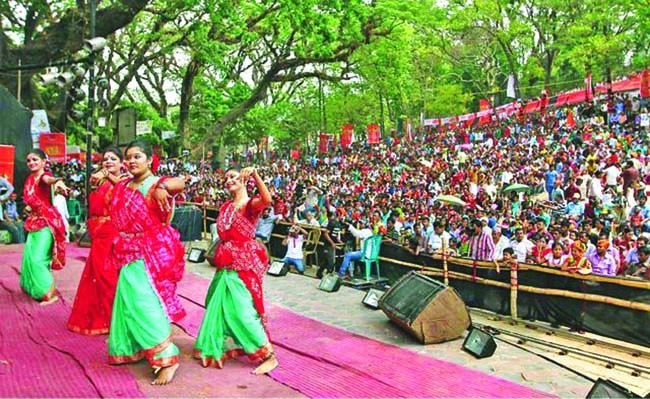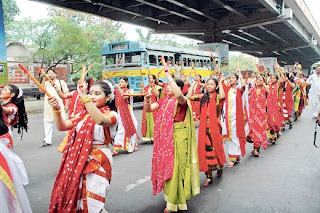Pohela Boishakh (Bangla New Year) Date – Friday, 14 April, 2023 in Bangladesh
What is Pohela Boishakh / Bangla New Year?
Bengali New Year is referred to in Bengali as “New Year” (Bengali: নববর্ষ Nôbobôrsho, from Sanskrit Nava(new) Barṣha(year) or “First of Boishakh” (Bengali: পহেলা বৈশাখ Pôhela Boishakh. Nobo means new, and Borsho means year. In Bengali, Pohela stands for ‘first,’ and Baishakh is the first month of the Bengali calendar.
Bengali New Year (Bengali: নববর্ষ) or Pahela Boishakh (পহেলা বৈশাখ) is the first day of the Bengali calendar, celebrated in both Bangladesh and West Bengal and in Bengali communities in Assam, Tripura, and Odisha and all over India as well where the Bengali community arises. It coincides with the New Year’s Days of numerous Southern Asian calendars. Poila Boishakh connects all ethnic Bengalis irrespective of religious and regional differences. In India, in West Bengal and Assam, it is a public (state) holiday and is publicly celebrated in mid-April. Bangladesh is a national holiday celebrated around 14 April according to the official amended calendar designed by the Bangla Academy.
 |
Celebration of Pohela Boishakh,Dhaka[Sincere Thanks to S.M. Tanvir Ayon for this Magnificent Snapshot] |
Boishakh/Baishakh is the first of the Bengali months where Pohela simply means “first”. The term “Pohela Boishakh” therefore, stands for the first day of the Bengali year and naturally refers to the festivity attached to this day as well. The celebration itself is called “Borsho Boron Utsab” or “Boishakhi Utsab” (the gala of Boishakh), which is held to welcome the Nobo Borsho (New Year). It is one celebration that goes beyond geographical borders as the Bengali New Year is celebrated in the West Bengal of India as well as in Bangladesh, making it the biggest cultural festival that has survived the last few centuries where Bengalis of all walks of life come together to make it colorful, bright and joyous.
Facts about Pohela Boishakh
Here are some interesting facts about Pohela Boishakh that you may not know:
- The traditional Bengali sweets, such as “roshogolla” and “mishti doi,” are an essential part of Pohela Boishakh and are often exchanged as gifts between friends and family members.
- Pohela Boishakh is also celebrated in other parts of the Indian subcontinent, such as West Bengal and Assam, – The “Mongol Shobhajatra” procession, which has become synonymous with Pohela Boishakh, was recognized by UNESCO as a “Masterpiece of the Oral and Intangible Heritage of Humanity” in 2016.
- Pohela Boishakh is also an important occasion for business and commerce, with many shops and markets offering discounts and promotions to attract customers. The day is considered auspicious for starting new ventures or making investments.
- Pohela Boishakh has also gained global recognition in recent years, with various diaspora communities organizing cultural events and festivals in different parts of the world.
Origin & History of Pohela Boishakh:
Who Started Bengali New Year?
The story of the pohela boishakh history has a few versions. However, they all go back to one particular Mughal emperor, Akbar the Great, and the tax collecting process under his reign (1556-1609). Several hundred years ago, the economy almost entirely depended on agricultural production. In Bengal, agriculture necessarily revolved around its six seasons. Under the Mughals, the tax was collected on the basis of Arabic or Hijri year, which did not exactly go hand in hand with the seasonal cycle of this region. For instance, when it was time for the landowners to collect taxes, the peasants would still be waiting to reap their products from the fields.
This way, following a lunar calendar that hijri year was based upon proved inconvenient for all the parties involved. Realizing the urgency of reformation in the existing year system, the Baadshah (emperor) gave one of the many renowned scholars of his court, Fatelluah Shiraji, the responsibility to make the necessary amendments. The new calendar was designed to keep all six seasons’ nature, duration, and contribution to agriculture in mind. Some scholars argue that Pohela Boishakh (1st boishakh) was anything but a reason for festivity for the peasants who comprised the majority of the population when they had to pay off their taxes on the last day of Chaitra/ Choitro, the month before Boishakh.
Besides, the landlords, to collect the taxes, often subjected the grassroots people to physical force. Such circumstances were most unlikely to leave people in a mood for festivity by the time the Pohela Boishakh was knocking on their doors. Despite having enough reasons for it to be contrary, Pahela Baishakh was a time for celebration. To avoid any serious rebellion, Badshah Akbar introduced the masterfully crafted custom of the New Year celebration that took place right after the tax-paying day. The amusements and feasts that used to be arranged helped to smoothen the harshness of the tax paying and sow the hopes for a better year among all.
As mentioned earlier, the celebration of Bengali New Year, pohela Boishakh, takes place both in West Bengal and Bangladesh. But, Pahela Boishakh in Bangladesh did not receive a collective form until 1965. During the growing movement for an independent state from Pakistan that began at the end of the 1940s and continued until independence in 1971, the former Pakistani Government implemented many policies that were somewhat modified versions of the British “Divide and Rule” principle.
In other words, those policies were meant to differentiate a Bengali Muslim from others and avoid a strong, joint movement for independence. As a continuation of such steps, the Pakistani government banned poems by the Noble winning Bengali author, Shree Rabindranath Tagore. Then, Chhayanaut, the only major Fine Arts institution of the time, designed their cultural show for Poila Boishakh to be a means of protest. The Pohela Boishakh takes place under the Banyan tree of Ramna Park in Dhaka ever since it was opened with Boishakhi songs by Tagore.
This way, Pohela Boishak became one with the nationalist notions of the Bengali people who resided in East Pakistan, known as Bangladesh today. The Fine Arts Institute (CharuKala Institute) of Dhaka University enhanced the attraction of the day in the late 1980s by adding Boishakhi Parade (Shobha Jatra) to ensure growing participation and acceptance. Soon, an attempt by a few hundred people to uphold the Bengali traditions and unify Bengalis while doing it transformed into a national event.
The Bengali New Year celebration in West Bengal also ties to religious values. The entire month of Boishakh is considered auspicious. Therefore, the first day by itself is reason enough for festivity. For the Hindu, the day begins with Puja (religious ritual) followed by cultural shows. Because it is considered auspicious, Boishakh is the month when most Hindu weddings occur in both Bengals.
Aspects & Activities of Pohela Boishakh:
How is Pohela boishakh celebrated?
In Bangladesh, the day begins before the break of dawn when a crowd gathers in Ramna Park for the Cultural show held by Chhayanat every year. Women mainly wear white Sharee (tips for women’s fashion on pohela boishakh) with a red border. Since Boishakh brings spring, women adorn their hair with flowers and wear colorful churi (bangles), symbolizing the many colors and renewed life in nature. On the other hand, men mainly wear traditional Punjabi (Panjabi price in Bangladesh) with Paayjama, Lungi, or Dhuti/Dhoti.
- Boishakhi Parade (Mongol Shova jatra): Boishakhi Mongol Shobha Jatra is one of the biggest attractions of the day. The rally starts at the CharuKala Institute of Dhaka University very early in the morning.
 |
| Mongal Sobhajatra in Pohela Boishakh |
- Boishakhi Fair (Mela):
It is arranged all over the country and continues for at least a week. A wide range of products and activities make the fair attractive to all age groups. Find their way here, from home accessories to anything and everything that speaks Bengali authenticity. One of the fun aspects of the Boishakhi Mela is the joy ride like the Merry-Go-Round and Ferris wheel. The ones seen in this fair are different in that they are much smaller, with a simpler structure made of wood and bamboo and lacking engines to run them. Instead, two or more men stand beside these rides to push.
 |
| Fair in Pohela Boishakh |
- Alpona:
In the front yard and staircases, miniature Aalponas or Rangolies, traditional designs, are drawn using bright colors like red, green, blue,
and yellow, as well as powdered rice. Drawing gigantic Aalponas on the main streets and walls all night long is one fun activity in which both males and females participate.

Pohela Baishakh 1421 adorned with Airtel Alpona
- Haalkhata:
It is the ritual of closing the old Ledger and opening a new one with new entries on Pohela Boishakh. Traders involved in the gold, clothing, or food business send out invitations to old customers and entertain them with sweets.
On the 1st day of Pohela Boishakh,businessmen greets their customers with sweets,
commence a “Halkhata”(new ledger)& lock their old ones. Source:Star file photo
- Sports:
Rural sports such as Nouka Baich (boat race), Kite flying, Bull Racing, and flying pigeons are popular.

Nouka Baich (Boat Racing) Image Source : worldphoto.org
Cultural Activities of Pohela Boishakh
Folk songs such as Palagan, kavigan, Jarigan, Gambhira gan, Gazirgan, baul, marfati, murshidi and bhatiali songs are staged. So are Jatra (one kind of plays) and other form of Bengali performing arts.
Pohela Boishakh in Dhaka
New Year’s festivities are closely linked with rural life in Bengal. Usually, on Pahela Boishakh, the home is thoroughly scrubbed and cleaned; people bathe early in the morning and dress in fine clothes. They spend much of the day visiting relatives, friends, and neighbors. Special foods are prepared to entertain guests. This rural festival has become enormously big in the cities, especially in Dhaka.
Boishakhi fairs are arranged in many parts of the country. Various agricultural products, traditional handicrafts, toys, cosmetics, as well as various kinds of food and sweets are sold at these fairs. The fairs also provide entertainment, with singers and dancers staging jatra (traditional plays), pala gan, kobigan, jarigan, gambhira gan, gazir gan and alkap gan. They present folk songs as well as baul, marfati, murshidi and bhatiali songs. Narrative plays like Laila-Majnu, Yusuf-Zulekha and Radha-Krishna are staged. Among other attractions of these fairs are puppet shows and merry-go-rounds.

Bauls performing in Pohela Boishakh
Pohela Boishakh Games
Many old festivals connected with New Year’s Day have disappeared, while new festivals have been added. With the abolition of the zamindari system, the punya connected with the closing of land revenue accounts has disappeared. Kite flying in Dhaka and bull racing in Munshiganj used to be very colorful events. Other popular village games and sports were horse races, bullfights, cockfights, flying pigeons, and boat racing. Some festivals, however, continue to be observed; for example, bali (wrestling) in Chittagong and gambhira in Rajshahi are still popular events.
Pohela Boishakh Food
Observance of Pohela Boishakh has become popular in the cities. Early in the morning, people gather under a big tree or on the bank of a lake to witness the sunrise. Artists present songs to usher in the new year. People from all walks of life wear traditional Bengali attire: young women wear white saris with red borders and adorn themselves with churi bangles, ful flowers, and tips (bindis). Men wear white paejama(pants) or lungi(dhoti/dhuti) (long skirt) and kurta (tunic). Many townspeople start the day with the traditional breakfast of panta bhat (rice soaked in water), green chilies, onion, and fried hilsa fish.

Panta Ilish(পান্তা ইলিশ) – a traditional platter of leftover rice soaked in water with fried Hilsa(ইলিশ), supplemented with dried fish (Shutki/শুঁটকী), pickles (Achar), lentils (dal), green chilies and onion – a popular dish for the Pohela Boishakh festival.
Pohela Boishakh Songs
The most colorful New Year’s Day festival takes place in Dhaka. Large numbers of people gather early in the morning under the banyan tree at Ramna Park, where Chhayanat artists open the day with Rabindranath Tagore’s famous pohela boishakh song, এসো, হে বৈশাখ, এসো এসো Esho, he Boishakh, Esho Esho (Come, O Boishakh, Come, Come). A similar ceremony welcoming the new year is also held at the Institute of Fine Arts, University of Dhaka. Students and teachers of the institute take out a colorful procession and parade around the campus. Social and cultural organizations celebrate the day with cultural programs. Newspapers bring out special supplements. There are also special programs on the radio and television.

Borsho Boron at Ramna Botomul. Source : bdnews24 photo archive
The historical importance of Pohela Boishakh in the Bangladeshi context may be dated from the observance of the day by Chhayanat in 1965. In an attempt to suppress Bengali culture, the Pakistani Government banned poems written by Rabindranath Tagore, the most famous poet, and writer in Bengali literature. Protesting this move, Chhayanat opened their Pohela Boishakh celebrations at Ramna Park with Tagore’s song welcoming the month. The day continued to be celebrated in East Pakistan as a symbol of Bengali culture. After 1972 it became a national festival, a symbol of the Bangladesh nationalist movement, and an integral part of the people’s cultural heritage. Later, in the mid-1980s, the Institute of Fine Arts added color to the day by initiating the Boishakhi parade, which is much like a carnival parade.
CHOTTOGRAM, Bangladesh | চট্টগ্রাম, বাংলাদেশ
The center of attraction of the Pohela Boishakh celebrations in the port city Chottogram is the DC Hill Park [ডিসি পাহাড় পার্ক]. Sammilitō Sanskritik Jot [সম্মিলিত সাংস্কৃতিক জোট] organizes a two-day festival to bid farewell to the old year and welcome the New Year. Various cultural events are organized here, including plays, etc. The public celebration of Poyela Boishakh in Chottogram was started in 1973; the politicians took the initiative to promote Bengali culture.

Festive Mood in Chattogram DC Hill. Image Source: Daily Asian age.
- Chottogram Hill Tracts | চট্টগ্রামের পার্বত্য জেলা :
In the Hill tracts of Chattogram, three different ethnic minority groups have their individual New Year celebrations. Boisuk [বৈশুখ] of Tripura People, Sangrai [সাংগ্রাই] of Marma people, and Biju [বিজু] of Chakma people; presently they have come together to celebrate it commonly as Boi-Sa-Bi [বৈ-সা-বি], a day of a wide variety of festivities; especially need to mention the water festival [জল উৎসব] of the Marma people.
KHULNA, Bangladesh | খুলনা, বাংলাদেশ
College students make great effort in designing festoons, banners, and colorful masks for this event. A newly formed non-governmental cultural organization Shokha Moyukh celebrated Pohela Boishakh at the campus of Govt. B L College, Khulna. The rally was followed by a cultural function at the campus. The event was organized by the students with support from the college faculty. Pohela Boishakh is celebrated in Khulna with enormous joy and enthusiasm. People from all walks of life take part in the Borshoboron Rally (বর্ষবরণ পদযাত্রা) organized by Khulna Sonskriti Kendro(খুলনা সংস্কৃতি কেন্দ্র).
Inauguration of Pohela Baishakh Ceremony, 1423 at Khulna
Kolkata and West Bengal | কলকাতা এবং পশ্চিম বঙ্গ
Kolkata, the sovereign of Bengalis in India; witnesses some of the grand celebrations of Poyela Boishakh. In Kolkata and the rest of Indian/West Bengal, Poyela Boishakh and indeed the entire month of Boishakh is considered an auspicious time for marriages, opening of new business ventures etc. Choitro is the Last month of the Bangla year; the garment traders give special discounts throughout the month. The last day of Choitro, is celebrated as Choitro Sankranti among the Hindu community, and Charak Pujo is held on this day. On this very same day, Charak Mela/fair is organized in various parts of rural Bengal; some really miraculous acrobatics are performed by the members and these stunts are quite risky indeed.
 |
| Boishakhi Jatra, AJC Bose Road, Kolkata Courtesy: New Year Photo Gallery Blog |
Pohela Boishakh is also the occasion when the whole family comes for a get together; youngsters touch feet of elders seeking benediction (আশীর্বাদ), and peers greet each other Suvo Nôbobôrsho with a hug (Kolakuliকলাকুলি). The celebration remains incomplete without “mishti mukh” exchanging sweets with the near and dear ones. The day of Poyela Boishakh is a day of cultural events. Like Bangladesh, here also people wake up & bathe early in the morning and dress up in traditional Bengali attire. Many go for Probhat Pheri (a parade similar to “Shobhajatra” in Bangladesh, but it’s not as colorful as that) to welcome the first day of the New Year singing Rabindra Sangeet, here also the song “এসো, হে বৈশাখ, এসো এসো”Esho, he Boishakh, Esho Esho is very popular.
Businessmen open new accounting books (HalKhata) on this day; for the Bengali Hindu businessmen, HalKhata begins only after performing puja, “Swastik” sign is drawn on the HalKhata by the priests. Devotees are seen in front of the Kalighat temple (কালীঘাট মন্দির) in long queues late at night. Devotees offer Puja to receive the blessings of the almighty.
The Government of West Bengal organizes various fairs and cultural events in different parts of the state. The most famous of these is Bangla Sangit Mela(রবীন্দ্র সঙ্গীত), held at Nandan-Rabindra Sadan ground.
OTHER NATIONS | অন্যান্য দেশ
Apart from Bengal, Poyela Boishakh is also celebrated by the Bengali community living in the United Kingdom, the United States of America, Australia, etc.
Pohela Boishakh celebrations also mark a day of cultural unity without distinction between class or religious affiliations. Of the major holidays celebrated in Bangladesh, only Pohela Boishakh comes without any preexisting expectations (specific religious identity, gift-giving culture, etc.). Unlike holidays like Eid ul-Fitr, where dressing up in lavish clothes has become a norm, or Christmas, where exchanging gifts has become an integral part of the holiday, Pohela Boishakh is really about celebrating the simpler, rural roots of the Bengal. As a result, more people can participate in the festivities together without the burden of having to reveal one’s class, religion, or financial capacity.
Are You ready for pohela boishakh sale online? Then Download Daraz App now!
Frequently Asked Questions
Q: How is Pohela Boishakh celebrated outside of Bangladesh?
A: Pohela Boishakh is celebrated by Bengali communities and diaspora around the world, with cultural programs, music and dance performances, and traditional food fairs. It is also recognized as a public holiday in some countries, such as India and Nepal.
Q: What are some traditional foods eaten during Pohela Boishakh?
A: Some traditional foods eaten during Pohela Boishakh include “panta bhat” (fermented rice), “dal puri” (lentil-stuffed bread), “beguni” (deep-fried eggplant fritters), “shorshe ilish” (mustard-flavored hilsa fish), and “mishti doi” (sweet yogurt).
Q: What are some common greetings used during Pohela Boishakh?
A: Some common greetings used during Pohela Boishakh include “Shubho Noboborsho” (Happy New Year), “Shubho Nabo Barsho” (Happy New Year), and “Naba Barshaar Preeti O Subhechha” (Greetings and Wishes for the New Year).

With years of experience as a seasoned online shopper, I have developed a keen eye for the latest trends and technology in the E-commerce industry. The passion for discovering the best products and services on the web is matched only by love for sharing their findings with others.


Amazing
Thanks
This was a great blog regarding Boishakhi season. I was very enjoying every bit of the blog. Thanks for sharing your knowledge.